
| WWT Shows | CLICK TO: Join and Support Internet Horology Club 185™ | IHC185™ Forums |

|
• Check Out Our... • • TWO Book Offer! • |
Welcome Aboard IHC185™  Internet Horology Club 185
Internet Horology Club 185  IHC185™ Discussion Site Main Page
IHC185™ Discussion Site Main Page  Horological Discussions, Questions and Answers
Horological Discussions, Questions and Answers  European Pocket Watch Forum
European Pocket Watch Forum  Help Identify English Watch Case Maker
Help Identify English Watch Case Maker
 Internet Horology Club 185
Internet Horology Club 185  IHC185™ Discussion Site Main Page
IHC185™ Discussion Site Main Page  Horological Discussions, Questions and Answers
Horological Discussions, Questions and Answers  European Pocket Watch Forum
European Pocket Watch Forum  Help Identify English Watch Case Maker
Help Identify English Watch Case MakerPage 1 2
Go  | New Topic  | Find-Or-Search  | Notify  | Tools  | Reply to Post  |  |
| IHC Life Member |
Hello...I am trying to decipher the hallmarks on an English Watch Case housing a fusee movement. So far I have figured out the small letter "g" dates it to 1862 London, The Standard Mark of a crown with and a separate stamping of "18" I think indicates solid 18K gold, the assay office mark, leopards head. The case maker is JB with a small heart stamped underneath. Can anyone identify who the maker is/was? Thank You! Roger | ||
|
| IHC Life Member |
Roger, Do you have a photo you could post? That might help.... Regards, Jerry PS - I just noticed that John Woolsey started a new string on the 9th. here it is, maybe it will help.... Were your ancestors Watchmakers? | |||
|
| IHC Life Member |
Roger, I have a watch that was made by Sir John Bennett of London....I was wondering if the JB on your watch could be the same maker....except mine is silver... Regards, Jerry | |||
|
Roger, any chance of posting some shots of the watch plus hallmarks and casemaker's mark? Best regards John | ||||
|
| IHC Life Member |
John & Jerry...Thanks for your replies. I'll try to post pictures of the case and movement. I doubt if I'll be able to photograph the hallmarks since they are so small. Roger | |||
|
| IHC Life Member |
I took some pics. I hope they help with identification. I do have the rest of the parts for the movement, but I believe it is beyond reasonable repair. I will probably try to search out a working movement to fit the case. Anybody have any working fusee's 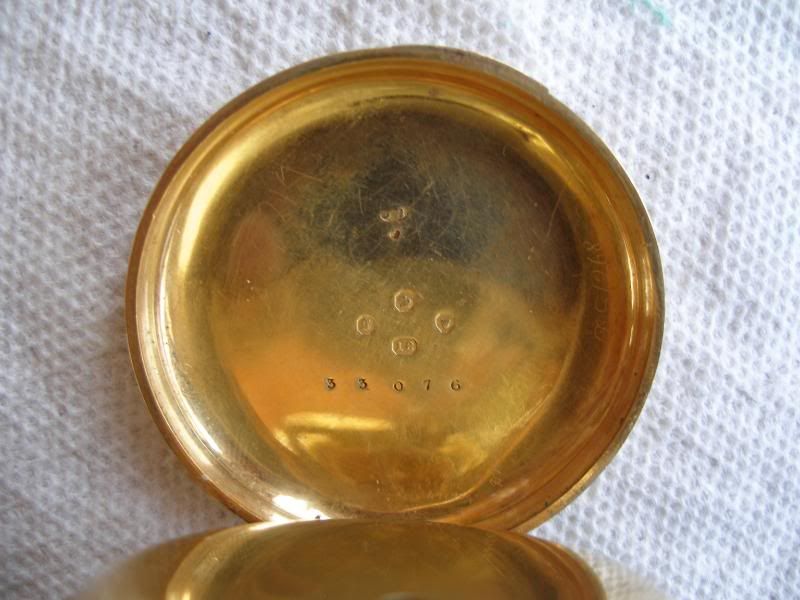 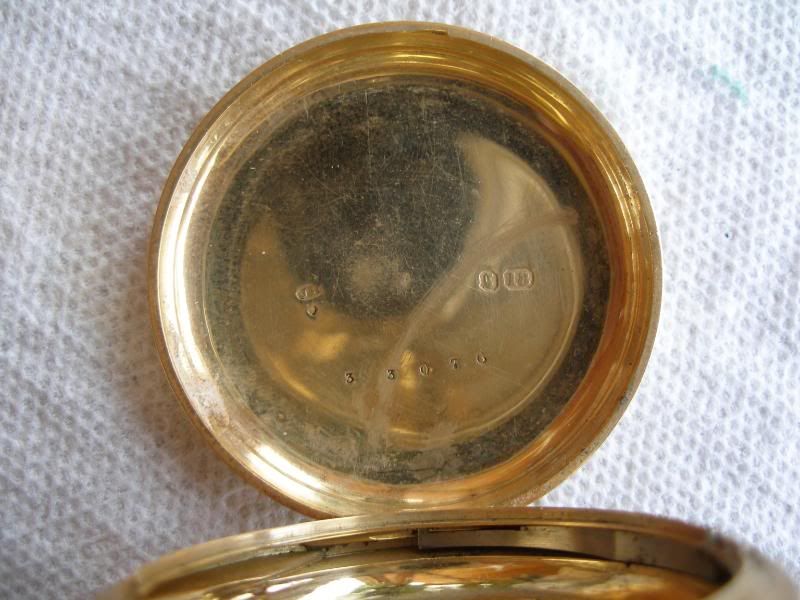 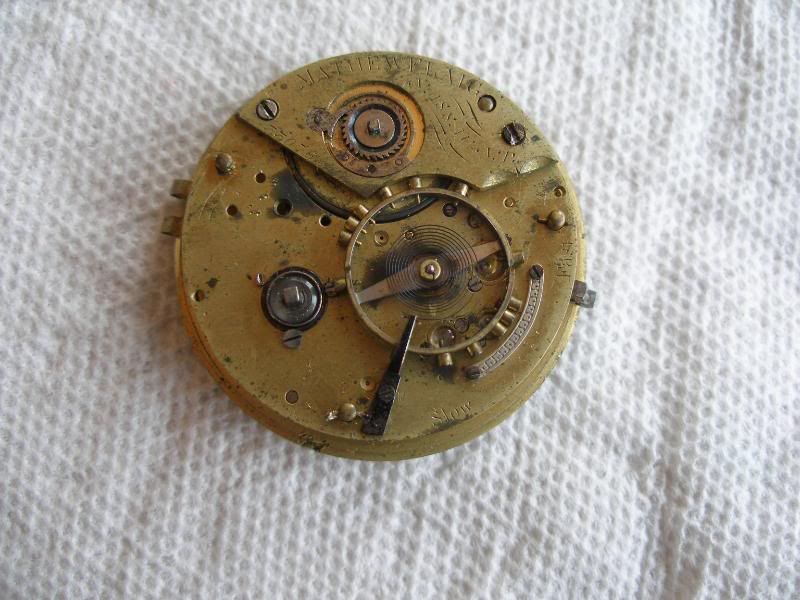 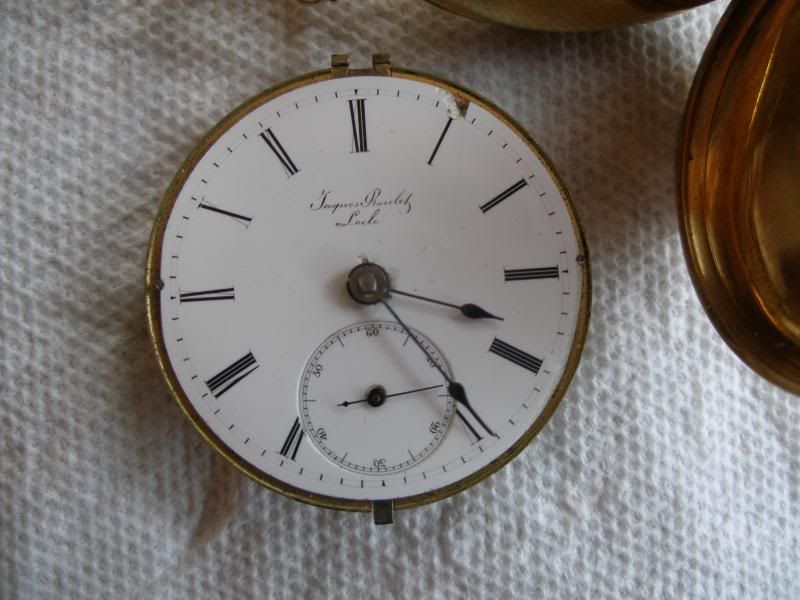 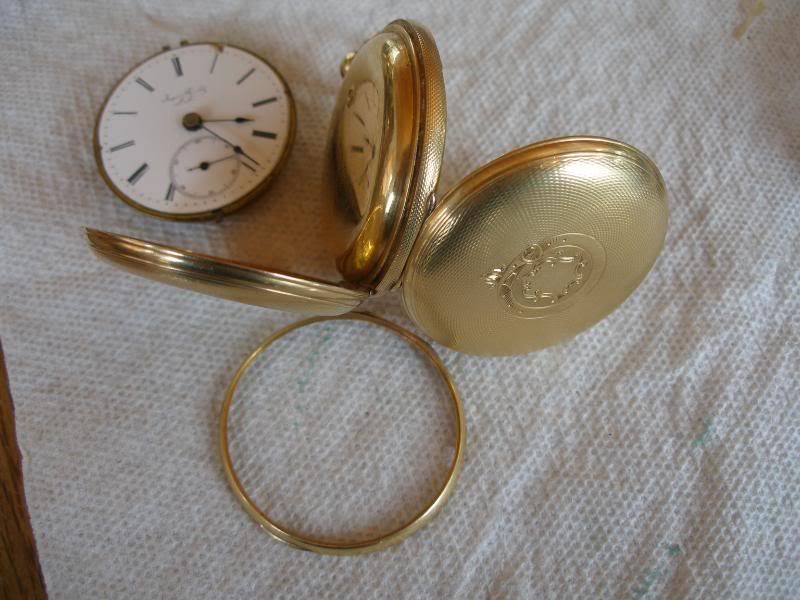 | |||
|
Hi Roger. Beautiful watch. Here is a link that shows hallmarks for various makers. Hope it helps you. http://swisswatchguy.blogspot.com/2008_02_01_archive.html IHC Member 1193 | ||||
|
| IHC Life Member |
Thanks for the link Chris. The hallmarks there are all Swiss, however. This case is English and the movement Swiss...as many were in those days. Maybe there is a comparable English blog? I'm including another couple of pics of the case. It is in amazing condition. Too bad it isn't mine. 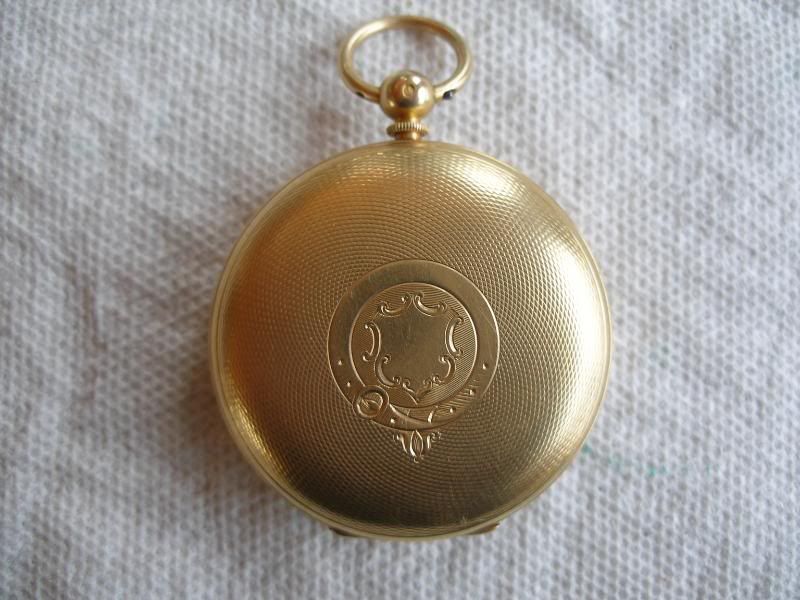 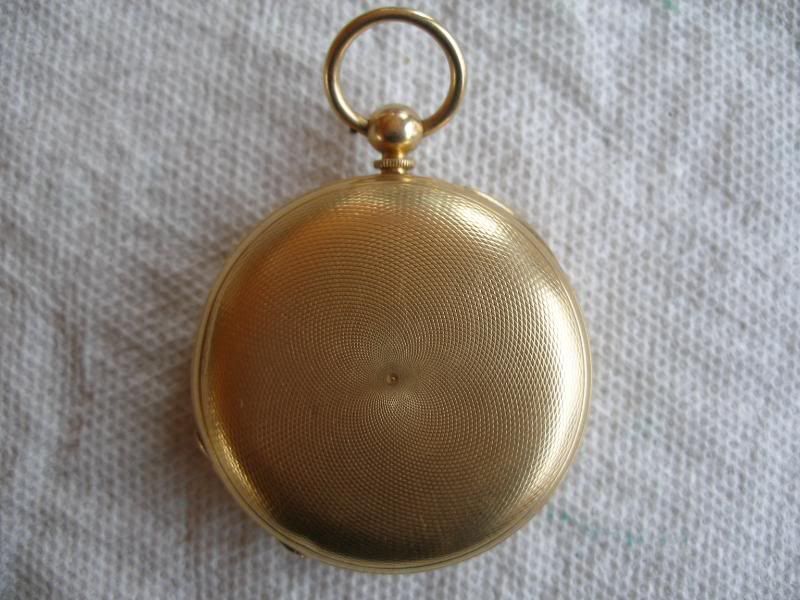 | |||
|
| IHC Member 179 E. Howard Expert |
Roger, NAWCC Bulletin Supplement #20 is the book you need to acquire. It lists all the English Hallmarks and the case makers. Philip Priestly is the author. There are at least 3 "JB" makers in this time frame, the shape of the cameo around the casemakers mark is also very important in determining the maker..... Harold | |||
|
Roger, I can't read the name on the movement, can you tell me what the name is and the place name? I don't think it's Swiss, but if it is, it'll be the first time I've seen one in the form of an English lever style movement. It could have a club tooth escape wheel or a pointed tooth form, can you check the escape wheel teeth and tell me which form they take? The dial is also held on by screws at either side, quite unusual for this type, and may not be original to the watch. What's actually wrong with it? and do you have the balance cock? I have working movements here and loads of spares for them - but matching stuff that fits is another story of course, as they were all hand made. It's not an easy deal swapping movements over either, as the cases were generally made to fit movements and the 'swing out' hinge bracket, then the key holes were drilled to match. Finding a movement even with the same back wind square position won't be easy. You'd be better off restoring the movement and keeping the watch original. The book that Harold mentioned is the one I use all the time, I'd recommend it to anyone that dabbles with English watches to any degree. Together with Bailllies & Loomes' wathmakers' references, they're invaluable resources. In my book, there's only one London based 'JB' using that shield, and it's John Bacon, 15 Goswell Rd, Clerkenwell and first registered that style mark on 11 Feb 1846 through to 8 July 1861 when he moved premises to 30 Claremont Place, Clerkenwell. 20th Dec 1865, he renamed (quite what it doesn't say)! Best regards John | ||||
|
| IHC Life Member |
Harold and John...Thank you for the help. I rarely get involved with European watches. Here is what is happening with this one. I was asked to look at two watches owned by the same gentleman for repair. One is a very nice Elgin that I have completed and the other is the subject of this topic. The case on this watch, as you can see from the pictures is beautiful. Getting to the movement, I was amazed to see all the problems it has. 1. The threads in the plate for the balance cock are stripped. (I have the balance cock and screw) 2. The balance staff is broken. 3. The lever has a broken pivot. 4. The banking pins are bent. And that is just an initial assessment without taking it apart! It looks like the watch was dropped, yet there is no evidence of that from the case. I called the gentleman who owns the watch to give him the bad news. He said it was his grandfathers watch and he would like to have it working, even if the movement were different. I thought the movement to be Swiss because of the dial with the word "locle" on the dial, but John, you bring up a good point...the dial may not be original. Anyhow, to answer more of your questions. The escape wheel is pointed, not club tooth. As best I can read from the plate it says: MATHEWFLAIG in all caps. Under that in a more fancy type, N.A*S.AU.N.P. (Substitute another "S" where the asterisk is. The family friendly sight banned the butt word. I believe the words on the dial say: Jaques Roulet Locle. I hope this additional info helps with identification and what I am dealing with. I forgot to turn that little voice on in my head that says, "Stay away from European watches, stay away from European watches, stay away...." I know it might be a stretch to find a replacement movement that will fit the case, but the cost to repair this one I think would be major $$$$. Any suggestions are welcome!! | |||
|
| IHC Life Member Site Moderator |
In the Loomes book I couldn't fing anything on a MATHEW FLAIG, but on line in a book called "The Jurist", which is a book for the year 1851 with an alphabetical list of bankrupts for London, shows a Matthew Flaig & John Alexander of Bath, Somersetshire & both watchmakers filing for bankruptcy. Tom | |||
|
Roger, it's pretty much as I suspected and is an English Lever movement. Tom's discovery of the watchmaker's banksuptcy was a nice find (even if an awful fate for the bankrupts languishing in a debtor's prison)! I can't make anything of the rest of the text on the movement though. The broken pallet staff is typical damage caused by a fully wound mainspring letting go, which could bend a banking pin if they're quite fine. I've known this event to also rip out or snap off a roller jewel. I suspect the broken staff had more to do with the stripped threads on the cock retaining screw. Personally, I'd still repair the movement, there's no damage there on the face of it, that you wouldn't find on any other abused watch, whether European or American, the difference being you often (most always) have to make or modify parts, rather than lift them out of a part bin or similar donor. Both the pallet and balance staffs will be relatively simple turnings compared to more recent stuff, so it would be worth talking to Chris Abell to see what he'd quote for doing them for you - he'd eat those alive!.(sorry in advance Chris if you don't doing like these) The stripped thread is a fairly straightforward repair with a couple of options: Re-tap the hole to suit a larger screw, and finish the screw head to match the rest on the plates. If the first option won't work, ream the hole clean and stake or solder in place a brass bushing, then re-tap that to suit the original screw. If the mainspring is bust, I may have a suitable new/old stock replacement here if I can have the size off the old one. These often come as a plain spring and you have to either bend the end into a hook or rivet a new hook in place, it probably Won't be 'T' ended. I may also have a suitable English dial, which may not be too difficult to change. These dials are pinned to a dial plate by taper pins, and this plate also carries the hinge bracket. The whole shebang is then pinned to the front plate of the movement. You should be able to see the arrangement looking between the plates. So as long as both hands pivot centres match, the dial foot position is often not critical. If it was my Grandfather's watch, I'd personally want the original movement ticking away in my hand just like it did when he had it, but that's just my 'family historian' mode kicking in If you're going to replace it anyway, send it over and I'll see what I can do with it! John | ||||
|
| IHC Life Member |
Tom...Thank you for the info. I would like to put together as much info as I can for the owner of the watch and this helps a lot!! Roger | |||
|
| IHC Life Member |
John...Thanks for the information you provided. It gives more options and food for thought. This movement had both banking pins bent parallel to each other. I am going to speak with the owner and see if he wants to possibly have Chris Abell give an estimate on repairs. I agree it would be far better to keep the original movement in the watch. The owner didn't seem to care so much about that. If he opts for a replacment movement AND I can get one, of course he still owns the original movement. If he doesn't want it back, I will happily send it off to you to see what you think. I REALLY appreciate the help with this. I specialize in American Pocket Watches and also the many similar variants. These older fusee's are a totally different animal. Roger | |||
|
I just noticed this thread and thought I would add a few cents worth. Sir John Bennett bought ebauches from Switzerland and used cases made by English artisans, operating from his jewelry store at 65,64 Cheapside, in London. This store location was destroyed by German bombs in WW II. Anyway, Roger, getting back to your original question, the letters "JB" do not refer to John Bennett. I have pictured below an example of one of his watches showing a typical case. Note the case makers initials: 'PW' (Phillip Workman). The letter dates the case to 1876. 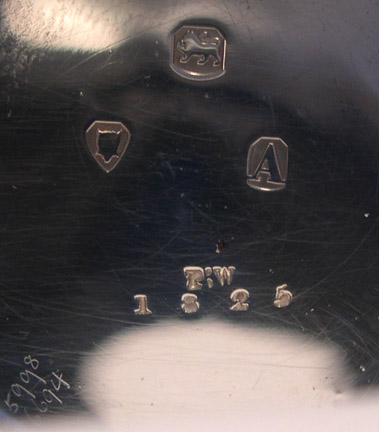 | ||||
|
Front lid of the hunter case: 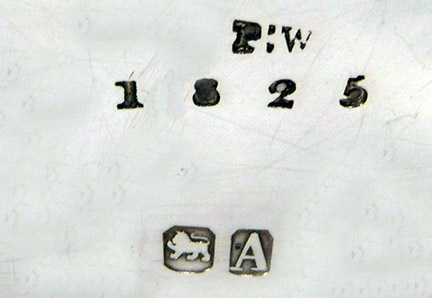 | ||||
|
Stylized dust cover shows Bennett's gift for showmanship and promotion. 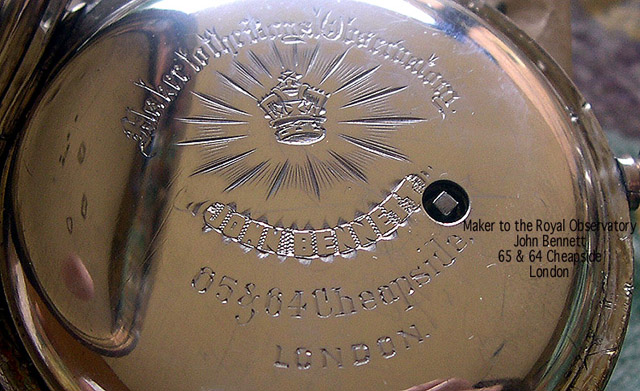 | ||||
|
The dial... 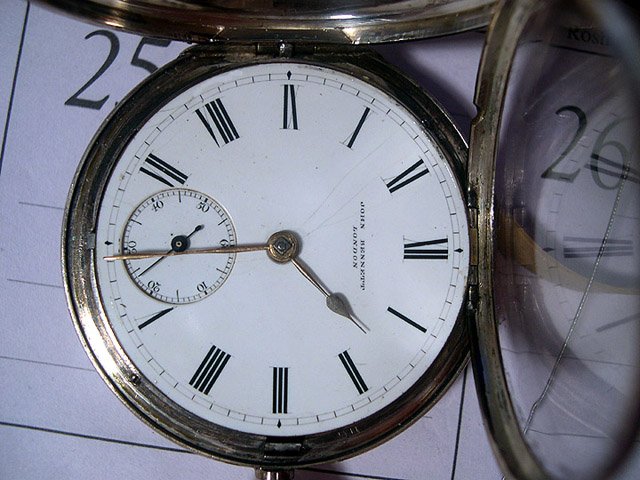 | ||||
|
The watch appears to be a "Liverpool Runner". It does not look good enough for that case. I wonder if it was a later marriage! Anyone else with a thought on this? | ||||
|
| IHC Life Member Site Moderator |
Roger I found some more on your watchmaker; 1841 Census Somerset, Walcot, Lansdown, District 14 Mathew Flaig 25 born about 1816 Clock maker, also listed with him were two other clock makers, Bernhard Kimerch 25 about 1816, Charles Foot 30 about 1811. All three are listed as born in Foreign Parts (which I assume to be elsewhere). Philadelphia Passenger Lists January 1852 ship City of Glasgow Mr & Mrs. Mathew Flaig immigrate to the USA, on the passenger list he is listed as a watchmaker & born in Italy & his wife in Germany, he is 37 & she 36. This would give him the year of birth of about 1815. 1860 US Census Virginia, Albemarle Fredericksville Parish He listed listed as a merchant jeweler & born in Germany & his wife Rosina born in England. Tom | |||
|
Jerry, What is a "Liverpool Runner"? Mike | ||||
|
| Powered by Social Strata | Page 1 2 |
| Your request is being processed... |
|
Welcome Aboard IHC185™  Internet Horology Club 185
Internet Horology Club 185  IHC185™ Discussion Site Main Page
IHC185™ Discussion Site Main Page  Horological Discussions, Questions and Answers
Horological Discussions, Questions and Answers  European Pocket Watch Forum
European Pocket Watch Forum  Help Identify English Watch Case Maker
Help Identify English Watch Case Maker
 Internet Horology Club 185
Internet Horology Club 185  IHC185™ Discussion Site Main Page
IHC185™ Discussion Site Main Page  Horological Discussions, Questions and Answers
Horological Discussions, Questions and Answers  European Pocket Watch Forum
European Pocket Watch Forum  Help Identify English Watch Case Maker
Help Identify English Watch Case Maker©2002-2025 Internet Horology Club 185™ - Lindell V. Riddle President - All Rights Reserved Worldwide

